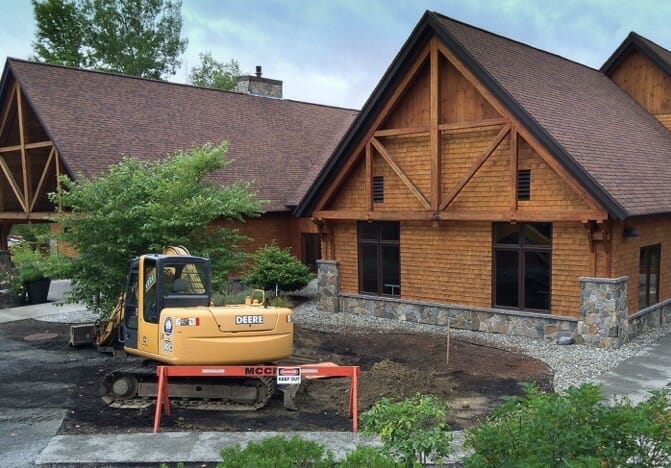
South Cove Activity Center Stormwater Management Plan
South Cove Activity Center Stormwater Management Plan at Eastman
By John Larrabee / Photo by Maynard Wheeler
When the South Cove Activity Center was completed in 2009, there were no gutters installed on the roof and there was a minimal landscaping plan. A stormwater management plan was submitted to and approved by the New Hampshire Department of Environmental Services (DES) when the building was permitted; however, large amounts of bark mulch were used to dress and cover the backfill around the building. Most of that mulch, along with garden soil, ended up in the lagoon on the waterfront. Mulch and soil also clogged the gaps in the previous drive at the entrance, rendering it impervious and accelerating erosion of the surface.
Members of the Youth Conservation Corps (YCC) and other volunteers, with consultation from Chief Community Living Officer Leslie Moses and Chief Maintenance Officer Mike Gornnert, addressed the stormwater runoff using best management practices (BMPs) as outlined by the Environmental Protection Agency. The BMPs included rain gardens, rain barrels, drip line infiltration trenches, dry wells, French curtain trenches, berms, and embankment beams with water bars to guide water slowly to the lake.
All these efforts, although effective to some degree, were not enough to prevent erosion. The backfill used to grade the building after construction was as compacted as concrete and could not absorb water slowly, resulting in a greater velocity of surface water that eroded gardens and mulch, especially during heavy spring and early summer rainfalls.
In addition, some of the implementations of the BMPs actually made pedestrian traffic more difficult. Stone-filled trenches and the permeable driveway trapped debris and became eroded and rutted, creating an unsafe surface for pedestrians and impeding access to the activity center and the pavilion.
More aggressive practices and permanent solutions were needed, so Mike gathered information and contracted with Peter Blakeman, of Blakeman Engineering, Inc., in North Sutton, for a site plan to deal with the stormwater runoff and resolve access problems. The site plan was completed in November 2014 and, because of the project’s proximity to the lake, a Shoreland Impact Permit was secured in July 2015 from DES.
The project will impact 26,100 square feet in order to improve storm water management. The site plan calls for the:
• replacement of concrete and asphalt
• addition of walkways to manage pedestrian circulation
• leveling the area that supports the canoe/boat rack to improve safety
• installation of four check dams to the existing swale below the culvert outlets at the northerly end of the site. (A check dam is a small, sometimes temporary dam to slow the velocity of stormwater.)
The Shoreland Impact Permit sets guidelines for work around woodland buffers, impervious surfaces, erosion and siltation, and clean fill, and sets surface water quality standards. The project contractors must use techniques set forth in the New Hampshire Stormwater Manual.
Mike explained that the project is being done in phases and will take approximately ten months to complete.
• Phase I, completed last fall, focused on the front entrance and included paving, improved drainage, and the installation of both gutters on the building and storm basins.
• Phase II focuses on the back of the building, with the installation of a drainage system featuring large underground basins, a concrete pad and an enclosure for dumpsters, a paved turnaround, and paved walkways compliant with the Americans with Disabilities Act (ADA).
• Phase III consists of the final cleanup, achieved by planting new grass, moving some existing plantings, and adding plantings and raised flowerbeds.
“There will be no work during the busy season, June-September. The contractor, McKenna Construction, is efficient, competent, and familiar with the project type and requirements. Staff at South Cove have been pleased with the project schedule and contractor modifications, allowing business as usual, with little disruption,” he said.
The project is going to make our South Cove Activity Center more beautiful and accessible. As with many things in life, if we have a little patience with a few disruptions, we can gain something even more wonderful
John Larrabee is a retired educator and administrator. He is chair of the Lakes & Streams Committee, supervises the Youth Conservation Corps, and volunteers for Kearsarge/Sunapee Habitat for Humanity and The Fells.
Request More Information from:
Receive your complimentary Relocation guide and magazine


